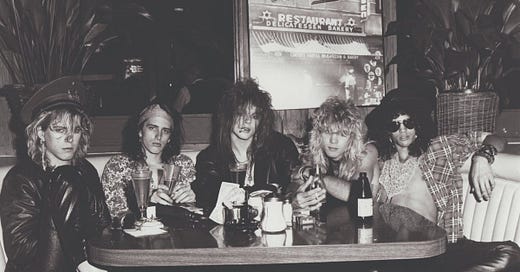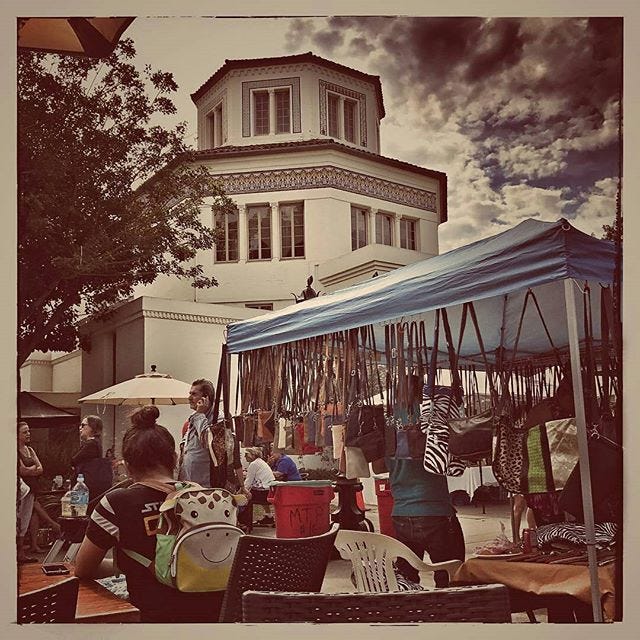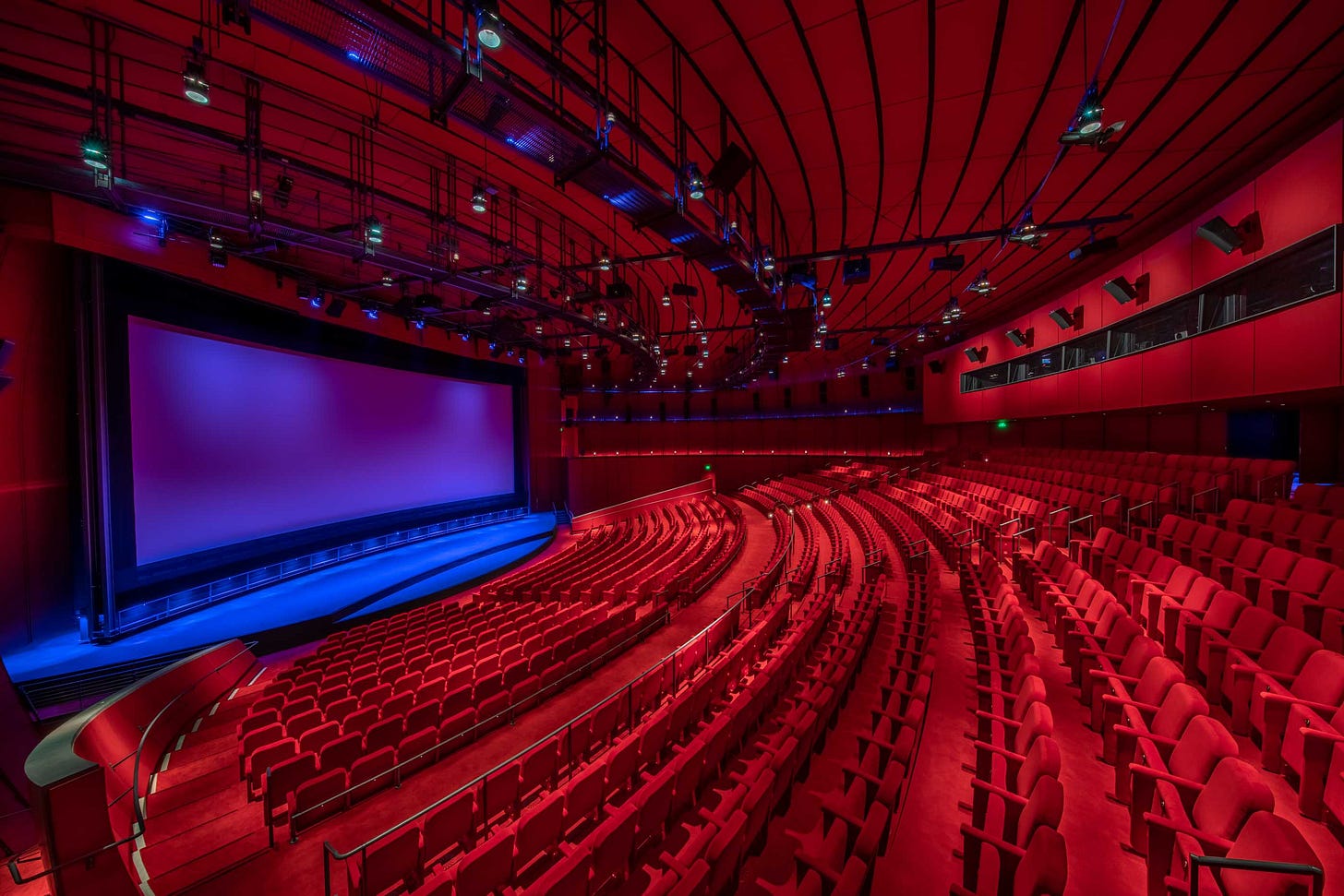Kibitz Room Confidential
How a dive bar led me on a cultural journey through Jewish delis, open mics, and the art of criticism in the heart of Los Angeles
One day I’ll tell you all about the legendary Canyon Country Store (and Lily’s Coffee stand) in Laurel Canyon, where Andrew and I met that fateful Sunday morning. For now, I want to focus on Los Angeles’s historic Fairfax district, where we ended up for dinner and after-dinner drinks. The Kibitz Room was, as far as we knew, just a convenient option across the street from Jon and Vinny’s. We had no idea they open the mic on Sundays for anyone to perform.
I didn’t even know the famous Canter’s Deli had its own dive bar to begin with. The Kibitz Room is cash only and they don’t serve food, although they won’t throw you out if you sneak in a knish through the curtain separating the bar from Canter’s proper. The Sunday night open mic is first come, first serve, one song at a time and get the hell off the stage. Like karaoke but real. Depending on how many people sign up, some musicians get to perform multiple times.
That evening we were treated to a wide range of artistry. It seemed like everybody there but us was a regular, it was all very friendly and very casual. The bartender hopped out from behind the well and did a couple numbers. Even Andrew plugged in his phone and displayed a side of himself that I didn’t know he had.
Since I moved into the neighborhood last year, I’ve slowly come to appreciate just how deeply arts and culture flow through the district and its namesake high school.
The members of Guns N’ Roses and Red Hot Chili Peppers are only the most noteworthy of countless Fairfax High alumni to make it in the entertainment industry. The next great American rock star may well be daydreaming away third period chemistry class as you read this Substack. Or they could be singing their amateur heart out down the street at Canter’s’ Kibitz Room.
Mediocre Dining
As great as the Kibitz Room is (for what it is), the food at Canter’s Deli is not actually good. It is an institution, you gotta give ‘em that. And it’s open twenty-four hours. If you simply must satisfy a craving for mediocre, overpriced matzo ball soup at 4 am, Canter’s is an excellent (if only) option. Nate ‘n Al’s in neighboring Beverly Hills is much, much tastier. But like Canyon Country Store, Nate ‘n Al’s doesn’t exist in the Fairfax District cinematic universe, so it only gets passing mention in this here chronicle.
As is the case with Nate ‘n Al’s, Canter’s is a Jewish deli, not a kosher deli. Many smaller, lesser-known bakeries, restaurants and grocers cater to the area’s clientele who follow stricter kosher or kosher-style dietary laws. The historic district has been home to one of the most populous Jewish communities west of the Mississippi River, with no less than two dozen Jewish schools and houses of worship currently operating in the area.
Now I’m just musing here, but if I know anything about historically Jewish occupations, I don’t think it’s a stretch to draw a line from old school haberdashers, furriers and fabric merchants to Fairfax’s identity as one of LA’s enduring fashion epicenters. The district is filled with high and low fashion businesses, from boutiques to by-the-pound consignment shops and specialty stores to cross-collaboration popups.
Budding merchants get a boost every Sunday from 10 to 5, when the sprawling high school campus transforms into Melrose Trading Post. Established to elevate artists, artisans and other small businesses, the Melrose Trading Post opened in 1997 as a project of the nonprofit Greenway Arts Alliance. Two years later, the alliance repurposed a student-built social hall named Greenway Court into a community arts space, hosting poetry slams, theater performances, and live podcasting. The building was originally erected in 1939 as a class project, but was later moved down the block to preserve its structure and further modernize the campus.
Since the high school opened a century ago, much of its original infrastructure has been torn down and rebuilt to accommodate the land’s propensity for earthquakes, although the historic auditorium and rotunda remain intact. I first set foot on campus that Sunday between our morning coffee date and dinner at Jon and Vinny’s, when Andrew insisted I check out the Trading Post. Vendors hocked everything from crystals and incense to snow cones to vintage vinyl and cowboy hats. I didn’t buy anything that day, but the experience alone was worth more than the price of admission.
Good Thrifting
As we meandered around, I marveled at the school’s notable architecture and design. Unfortunately we went too late in the day to catch any of the live music curated by the Arts Alliance. We window shopped, people watched, and chatted amongst ourselves. Although I chose not to buy anything, spending a couple hours with a friend immersed in this cultural bazaar was an afternoon extremely well spent. When I got there, I bristled at having to pay an entrance fee. By the time I walked out, I felt proud for having supported such a valuable organization.
I go through the same cycle of anger to acceptance to appreciation every time I go to Canter’s. The food may not be for me, but there’s something valuable about the institution itself, however decidedly mediocre. Tourists and ten year olds gotta eat, right? And aspiring musicians gotta get their reps.
Good Listening
The night we went, one regular in particular stood out to me: Matthew Walker, then by the stage name Egalitarian Steve, sang sweet, soulful and catchy songs. He was genuinely friendly and outgoing, naturally sparking up a conversation with Andrew and me. When I asked about his influences, one surprised me: Lana Del Ray. At that time, aside from Young and Beautiful (remember: The Great Gatsby is my skeleton key) I knew nothing of the native East Coaster turned canonically named West Coaster. But after that night I dove into her catalogue.
And holy shit. Lana Del Ray is good. Really, incredibly good.
You, my culturally attuned reader with impeccable taste, probably knew that already. But for me, back in 2022, it was a revelation. Over time I gradually explored more and more of her music, until a few months ago when I first heard The greatest. And then I listened to it again. And again (the song is #4 on my Spotify 2024 most played). And again, until—you guessed it–I broke down in tears.
Part eulogy, part love ballad, part post-apocalyptic memoir, The greatest pours forth Lana Del Ray’s tender molten broken heart.
“The greatest loss of them all” is first and foremost personal, the loss of innocence and raw vitality that fades with age. It’s also a cultural death, embodied by the centrality of livestreams and the decrepitude of the once great Kanye West. The greatest loss is planetary collapse, in which the only silver lining comes as a poetic prophecy from Bowie’s Life on Mars.
And no one hits the silver line like Lana Del Ray.
The song balloons over three acts, from a soft piano opening to full orchestra, and finally back to a delicate piano outro. The range of loss expands outward from the personal to the societal to the species as a whole. As the musical and emotional stakes rise, Del Ray dials up with matching meters of power and truth.
Where others might become numb or cynical within a slowly warming cauldron of such epic loss, Del Ray channels the pain and perspective into a triumph of post twentieth century tragedy. This song is not for the faint of heart. It is just too real.
Despite her greatness, Lana Del Ray has never been nominated for an Oscar. The subjective, collective honors of the Academy have eluded many greats over the years, but that wasn’t going to stop me from taking in a free dinner and quality time with a friend at the Academy Museum of Motion Pictures’ annual member appreciation holiday party.
Located further down Fairfax at Wilshire, the museum opened in 2021 next to the Los Angeles County Museum of Art and the prehistoric La Brea Tar Pits. Alongside its gallery exhibitions, The Academy Museum boasts the magnificent Geffen Theater where you can see classics like Chinatown and Close Encounters of the Third Kind. A friend and museum member has graciously invited me to see films there and, more recently, to attend the holiday party as his guest.
The night of the holiday party, we checked out the new Cyberpunk exhibit and debated the meaning of Kubrick after attending the member reception. As I sipped cheap champagne and scarfed down a dinner’s worth of cheese, meats and accoutrements, we mingled with a couple working in entertainment. They were delightful company, full of fun anecdotes and strong opinions.
After revealing my own creative lane as a Substack author, I asked the husband (and significantly more vocal member of the pair) if he would ever consider publishing his cultural criticism on the platform. Pointing to a professional preclusion from attaching his name to negative views of other artists, he listed the three extremely successful filmmakers for whom he is willing to make an exception: Quentin Tarantino, Ridley Scott, and Taylor Sheridan.
Only in Los Angeles would you meet people with principled stances against publicly critiquing others in their field, who also have a cocktail party-ready exception to that stance, complete with a litany of examples ready for your listening pleasure.
As I chomped down my brie, soppressata and cornichons I was treated to some delightfully enthusiastic Tarantino critiques. This man’s exceptionalized disdain was the perfect dessert for my makeshift meal.
As Nick Hornby reminds us in High Fidelity, taste–and especially good taste–is as much a function of what you don’t like as it is about what you do like. And when you don’t like something, or someone, so much that you devote an entire podcast to that hatred? That in itself can rise to the level of good art. That is why I love I Hate Bill Maher.
More Good Listening
Each episode of this charming hate fest begins with a disclaimer: there will be no growth, no epiphany, no transcendent discovery of empathy for Bill Maher. It’s a celebration of hatred, and that’s all it will ever be. Canadian comic Will Weldon reviews episodes of HBO’s Real Time with Bill Maher, with special installments dedicated to other Maher content or guests with singular Maher experiences. Most episodes enlist guests from the comedy world to help savage Real Time on substance, style, and comedic quality.
Personally, I choose to hate-watch Bill Maher because this man is a skeleton key for so much that has gone wrong in our culture over the last thirty years. Will Weldon may not want to explore the deeper darker meaning of it all, but I have to know. I have gone so far as to scour the internet for thoughtful takedowns penned by the ideologically aligned, so as to better elaborate and validate my deeply held disdain. Nothing I found ever satisfied–until now.
Yes, Maher is anti-gay, anti-trans, islamophobic, sexist, racist, ethnonationalist, fatphobic, and a class warrior (against the poor, in case there was any confusion about his world view). But atop his unexamined and unrepentant bigotry Maher is, according to Weldon, a shitty comedian and a prolific creator of bad TV. Comedy and TV are foreign realms to me, so I especially appreciate the podcast’s demonstration of just how impoverished Maher is as a comedian, host, and producer.
With respect for Weldon’s choice to eschew deeper insight, his podcast nonetheless provides invaluable exploration of the rancid raw material at the root of it all. Until I write my own elaborate manifesto illustrating Bill Maher’s central significance to the total downfall of civilization (with the help of I Hate Bill Maher), I’m simply going to enjoy listening to people who love savaging this man even more than I do. It makes me feel sane. It makes me feel like my worldview makes sense, in a world that seems to make less and less sense every day. And it’s hysterically funny.
When something is just plain entertaining, all politics and cultural impact aside, that makes it good. Full stop.
A work colleague recently invited me to a poetry slam at the Greenway Court Theater. I was too tired to join him after work, but I lit up just hearing a friend from another part of town invite me to that cultural gem in my own neighborhood. I smile when I walk by a long line of sneakerheads camping out until the collectible drop shop opens. I’m thankful for the fresh-baked bialy I will never eat. I will also likely never take advantage of the West African spot advertising its signature jollof rice across the street from the Taco Bell I patronize with, as you already know, embarrassing frequency.
With each economic cycle and progressive waves of immigrants, the vibrant Fairfax district changed and evolved countless times before I got here–and will continue to recreate itself after I’m gone. I’m just grateful to have lucked into it for the short time that I’m here. As Lana Del Ray says, “the culture is lit, and if this is it, then I had a ball.”










The kibbutz room has been a musician hang since before I got to LA in 1975. The food may have better then, or at least for a 20 year old transplant from Kansas. Greenblatts was a bit more gourmet but Canter’s had the soul and welcomed we misfits. KISS, Zappa, Eagles, the Runaways, Bette Midler, Al Kooper, Rod Stewart, pretty much any band, producer or engineer from the Record Plant on 3rd street could be found there on any given night before or after the Rainbow Room. An institution for sure.
I went to Cantor’s on my honeymoon and ran into Betty White in the bathroom.